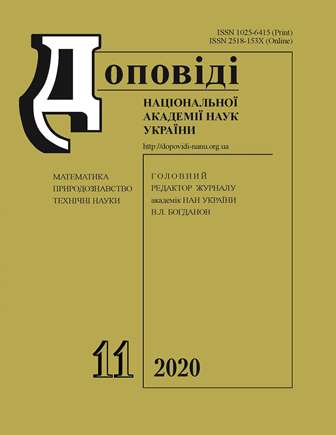Вуглеводні Мексиканської затоки: їх генезис та масштаби міграції на поверхню і в атмосферу
DOI:
https://doi.org/10.15407/dopovidi2020.11.051Ключові слова:
абіогенний генезис, бурштин, водень, вулкан, газ, газові сипи, глибинна будова, Мексиканська затока, нафта, нафтові сліки, обробка даних дистанційного зондування Землі, прямі пошуки, хімічні елементиАнотація
Наведено результати рекогносцирувального обстеження локальних ділянок розташування ряду нафтових сліків у різних районах Мексиканської затоки. Експериментальні дослідження з використанням прямопошукової технології частотно-резонансної обробки та інтерпретації супутникових знімків і фотознімків проведені з метою вивчення особливостей глибинної будови на ділянках розташування сліків. Результати інструментальних вимірювань свідчать про те, що всі дев’ять ділянок обстеження в затоці розташовані над вулканами, в межах яких здійснюється синтез нафти, конденсату та газу на межі 57 км. У контурах таких вулканів існують глибинні канали, по яких нафта, конденсат і газ мігрують у верхні гори зонти розрізу і можуть поповнювати вже сформовані поклади на родовищах ВВ. Якщо надійних покришок над такими каналами немає, нафта, конденсат і газ можуть мігрувати у водну товщу, а газ далі — в ат мосферу. У процесі такої міграції формуються газові сипи на морському дні і нафтові сліки на водній по верхні. Вимірами підтверджено наявність усіх раніше встановлених типів вулканів, у яких на глибині 57 км відбувається синтез ВВ. Це вулкани, заповнені: 1) сіллю, 2) осадовими породами, 3) вапняками, 4) гранітами, 5) ультрамафічними породами. Дослідженнями на ділянці в районі аварійної свердловини виявлено в затоці значну кількість вулканів, у межах яких немає умов для синтезу ВВ і бурштину. Це вул кани, заповнені: 1) доломітами, 2) мергелями, 3) кременистими породами, а також 4) базальтами і 5) кімберлітами. Принципово важливе значення мають отримані інструментальними вимірами додаткові свідчення на користь глибинного (абіогенного) генезису нафти, конденсату та газу. На підставі численних фактів фіксації сигналів від нафти, конденсату та газу на межі їх синтезу 57 км у Мексиканській затоці та в інших регіонах світу можна висловити припущення про міграцію абіогенного метану в ат мосферу Землі в колосальних обсягах! Метанові сипи і нафтові сліки можуть служити індикаторами ак тивності вулканів, у яких здійснюється синтез ВВ. У цих випадках буріння свердловин на ділянках роз ташування глибинних каналів міграції абіогенних ВВ у верхні горизонти розрізу може бути пов’язано з ве ликими ризиками — з аварійними ситуаціями під час буріння.
Завантаження
Посилання
Turkey finds 320 bcm of natural gas in Black Sea, Erdoğan announces. Retrieved from https://www.dailysabah.com/business/energy/turkey-finds-320-bcm-of-natur.
Yakymchuk, M. A. & Korchagin, I. M. (2020). New evidence in favor of the abiogenic genesis of hydrocarbons from the results of the testing of direct-prospecting methods in various regions of the world. Dopov. Nac. akad. nauk Ukr., No. 9, pp. 53-60 (in Ukrainian). https://doi.org/10.15407/dopovidi2020.09.053
Yakymchuk, N. A., Korchagin, I. N., Bakhmutov, V. G. & Solovjev, V. D. (2019). Geophysical investigation in the Ukrainian marine Antarctic expedition of 2018: mobile measuring equipment, innovative direct-prospecting methods, new results. Geoinformatika, No. 1, pp. 5-27 (in Russian).
Yakymchuk, N. A. & Korchagin, I. N. (2019). Technology of frequency-resonance processing of remote sensing data: results of practical approbation during mineral searching in various regions of the globe. Part I. Geoinformatika, No. 3, pp. 29-51 (in Russian).
Yakymchuk, N. A. & Korchagin, I. N. (2019). Technology of frequency-resonance processing of remote sensing data: results of practical approbation during mineral searching in various regions of the globe. Part II. Geoinformatika, No. 4, pp. 30-58 (in Russian).
Yakymchuk, N. A. & Korchagin, I. N. (2020). Technology of frequency-resonance processing of remote sensing data: results of practical approbation during mineral searching in various regions of the globe. Part III. Geoinformatika, No. 1, pp. 19-41 (in Russian).
Oil seepage an inconvenient truth-NPA seep information — GOM portion. Retrieved from https://www.slideshare.net/aeberman/oil-seepage-an-inconvenient-truthnpa.
“Electronic petrographic reference book-identifier of magmatic, metamorphic and sedimentary rocks” for operational use in the creation of Gosgeolkart1000/3 and 200/2 for the territory of the Russian Federation. St. Petersburg, 2015 (in Russian). Retrieved from http://rockref.vsegei.ru/petro/
##submission.downloads##
Опубліковано
Як цитувати
Номер
Розділ
Ліцензія
Авторське право (c) 2023 Доповіді Національної академії наук України

Ця робота ліцензується відповідно до Creative Commons Attribution-NonCommercial 4.0 International License.




